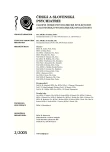Pesso Boyden Psychomotor Therapy in the Treatment of Traumatized in Patients, Survivors of Second World War in the Former Dutch East Indies
Pesso psychoterapie v klinické léčbě přeživších Druhou světovou válku z bývalé Nizozemské (Východní) Indie
Pesso psychoterapie pochází z počátku šedesátých let minulého století. Manželé Albert Pesso a Diana Boyden-Pesso, původem profesionální tanečníci, začali nejdříve asociovat pohybové problémy u tanečníků s emočními problémy. Později vypracovali psychomotorický terapeutický systém, použitelný v léčbě psychiatrických klientů. Základem této terapie je hraní rolí, naprosto odlišné od psychodramatu. Neverbální chování a traumatické události z minulosti jsou základem pro terapeutický scénář, jehož provedení funguje jako „antidótum“ ve vztahu k minulým, negativním zážitkům. Jde o individuální terapii ve skupině, kdy je celá skupina „ve službách“ klienta, který pracuje na svých problémech.
Klíčová slova:
Pesso psychoaterapie, traumata z Druhé světové války.
Authors:
J. M. Nerad
Authors‘ workplace:
Stichting Centrum 45, Oegstgeest, Nizozemsko
ředitel drs. J. W. Reerds, MBA
Published in:
Čes. a slov. Psychiat., 101, 2005, No. 2, pp. 88-91.
Category:
Comprehensive Reports
Overview
The very beginning of Pesso Boyden Psychomotor System dates in the early sixties of the twentieth century, when professional dancers – husband and wife Pesso – started to work with their student dancers at Emerson College. During decades they developed current complex and clearly defined therapeutic system, which is applicable to a wide variety of emotional, cognitive and bodily dilemmas. For clinicians, it offers an alternative which our usual therapeutic approaches often lack. Pesso psychomotor therapy is an individual therapy in the group, group members (“accommodators”) help a client enact a core problem (“the true scene”). Role-players are carefully guided by the therapist and this therapy bears no resemblance to a known use of role-playing. “Reading” of the client’s body energy, “staging” of internal dilemmas in an external, visual, auditive and tactile way, empathic “witnessing” and labelling of the client’s negative experience and the most important: providing the “antidote”, the crucial bodily and emotional support through the “ideal figures”, all this help clients of the former Dutch East Indies to overcome the trauma’s and betrayals of the Second World War.
Key words:
Pesso Boyden Psychomotor system, traumata of the Second World War.
Labels
Addictology Paediatric psychiatry PsychiatryArticle was published in
Czech and Slovak Psychiatry

2005 Issue 2
- Hope Awakens with Early Diagnosis of Parkinson's Disease Based on Skin Odor
- Memantine Eases Daily Life for Patients and Caregivers
- Memantine in Dementia Therapy – Current Findings and Possible Future Applications
- Deep stimulation of the globus pallidus improved clinical symptoms in a patient with refractory parkinsonism and genetic mutation
Most read in this issue
- Safety and Tolerability of Second and Third Generation Antipsychotics
- Prediction of Efficacy of Inpatient Treatment in Metamphetamine Dependence
- Psychosocial Stressors in Young Families from Brno and Znojmo Part II
- Pesso Boyden Psychomotor Therapy in the Treatment of Traumatized in Patients, Survivors of Second World War in the Former Dutch East Indies
